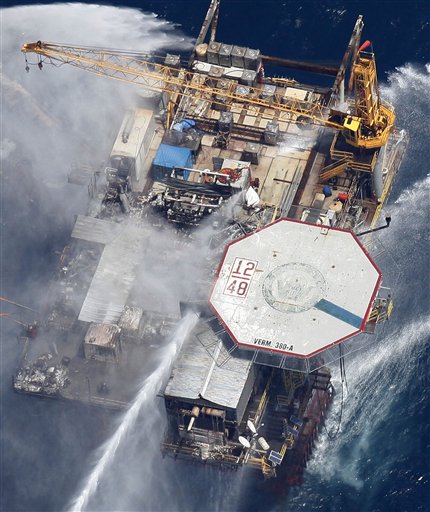UPDATE II: As of 5:30 p.m. ET, the Coast Guard is backing away from earlier reports of a mile-long oil slick near the site of the Vermilion platform. Mariner Energy, which owns the platform, told the Washington Post there is no slick, and the Coast Guard said it has not been able to confirm its earlier claim that there was a sheen on the water.
UPDATE: In an about face from what the Bureau of Ocean Energy Management said earlier today, Gov. Bobby Jindal is now saying that there were “seven active production wells on the platform,” according to a 4 p.m. ET Associated Press story. Jindal said the wells have now been shut down.
***
The news today of a fire on the Vermilion Oil Platform in the Gulf of Mexico summoned fears of a disaster on the scale of April’s Deepwater Horizon explosion. But how do the two incidents compare? Here’s a look at what we know right now:
- Vermilion Oil Platform 380 is anchored approximately 100 miles off the Louisiana coast. Deepwater Horizon stood in 5000 feet of water at the time of the April explosion; Vermilion stands in a mere 340 feet of water, Bureau of Energy Management Regulation and Enforcement spokeswoman Melissa Schwartz told the the AP.
- Coast Guard Petty Officer Matthew Masaschi told ABC that Mariner Energy has noticed evidence of a “slight oil sheen” near the platform measuring “one nautical mile by 100 feet.” In comparison, two days after the Deepwater Horizon explosion in April, a sheen of one by five miles was reported.
- The AP reported that a clean-up operation would be comparatively easy near the Vermilion since shallow-water spills do not require the use of “remote-operated vehicles access equipment on the sea floor.”
- Vermilion’s crew was significantly smaller than Deepwater Horizon’s. The doomed oil rig that exploded in April had 126 crew members on board; 11 were killed by the blast, and 17 were injured. In comparison, Vermilion carried only 13 crew members, all of whom are accounted for. There is one reported injury.
- Schwartz, the Bureau of Energy Management spokeswoman, told the AP that there were “maintenance activities underway” on the oil platform and that the platform was not producing oil or gas at the time of the explosion.
- A press release from platform owner Mariner Energy said Vermilion was producing both oil and gas as recently as last week. The press release said, “During the last week of August 2010, production from this facility averaged approximately 9.2 million cubic feet of natural gas per day and 1,400 barrels of oil and condensate.” The Deepwater Horizon was drilling 8,000 barrels of oil when it exploded and had 700,000 gallons of diesel fuel on board.
- The oil leaking from Deepwater Horizon was not detected on the day the rig exploded. It was only two days after the initial explosion (and after the rig itself had sunk) that CNN reported the discovery of an oil slick at the site.

